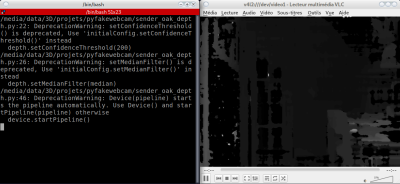streamer_des_images_opencv_avec_v4l2-loopback
Ceci est une ancienne révision du document !
Table des matières
Streamer des images OpenCV avec v4l2-loopback
Le stream avec zeromq est sans latence, mais ne peut pas être reçu par Pure Data et VLC.
v4l2-loopback a un peu de latence (0.1 à 0.2 seconde) en lecture dans VLC, mais pas de latence si lecture avec OpenCV
Nous utilisons pyfakewebcam
Ressources
pyfakewebcam Il y a divers projets qui font ça sur GitHub, celui ci à cette qualité de marcher!
Sources des exemples
Installation
A voir, nécessaire mais peut-être pas suffisant:
sudo apt install v4l2loopback-utils
sudo apt install python3-pip python3 -m pip install --upgrade pip sudo apt install python3-venv cd /le/dossier/de/votre/projet python3 -m venv mon_env source mon_env/bin/activate python3 -m pip install opencv-python pyfakewebcam
Exemple simple pour tester
- cam_relay.py
""" Insert the v4l2loopback kernel module. modprobe v4l2loopback devices=2 will create two fake webcam devices """ import time import pyfakewebcam import cv2 import numpy as np cap = cv2.VideoCapture(0) camera = pyfakewebcam.FakeWebcam('/dev/video1', 640, 480) while True: ret, image = cap.read() if ret: # # gray = cv2.cvtColor(image, cv2.COLOR_BGR2GRAY) camera.schedule_frame(image) if cv2.waitKey(1) == 27: break """ Run the following command to see the output of the fake webcam. ffplay /dev/video1 or open a camera in vlc """
Exécuter le script avec:
cd /le/dossier/de/votre/projet modprobe v4l2loopback devices=2 ./mon_env/bin/python3 cam_relay.py
Dans un autre terminal
ffplay /dev/video1
Il faudra peut-être adapter les numéro de /dev/video
Profondeur d'une OAK-D Lite
cd /le/dossier/de/votre/projet source mon_env/bin/activate python3 -m pip install depthai numpy
- sender_oak_depth.py
import cv2 import depthai as dai import numpy as np import pyfakewebcam pipeline = dai.Pipeline() # Define a source - two mono (grayscale) cameras left = pipeline.createMonoCamera() left.setResolution(dai.MonoCameraProperties.SensorResolution.THE_400_P) left.setBoardSocket(dai.CameraBoardSocket.LEFT) right = pipeline.createMonoCamera() right.setResolution(dai.MonoCameraProperties.SensorResolution.THE_400_P) right.setBoardSocket(dai.CameraBoardSocket.RIGHT) # Create a node that will produce the depth map # (using disparity output as it's easier to visualize depth this way) depth = pipeline.createStereoDepth() depth.setConfidenceThreshold(200) # Options: MEDIAN_OFF, KERNEL_3x3, KERNEL_5x5, KERNEL_7x7 (default) median = dai.StereoDepthProperties.MedianFilter.KERNEL_7x7 # For depth filtering depth.setMedianFilter(median) # Better handling for occlusions: depth.setLeftRightCheck(False) # Closer-in minimum depth, disparity range is doubled: depth.setExtendedDisparity(False) # Better accuracy for longer distance, fractional disparity 32-levels: depth.setSubpixel(False) left.out.link(depth.left) right.out.link(depth.right) # Create output xout = pipeline.createXLinkOut() xout.setStreamName("disparity") depth.disparity.link(xout.input) camera = pyfakewebcam.FakeWebcam('/dev/video1', 640, 480) with dai.Device(pipeline) as device: device.startPipeline() # Output queue will be used to get the disparity frames from the outputs defined above q = device.getOutputQueue(name="disparity", maxSize=4, blocking=False) while True: inDepth = q.get() # blocking call, will wait until a new data has arrived frame = inDepth.getFrame() frame = cv2.normalize(frame, None, 0, 255, cv2.NORM_MINMAX) depth_gray_image = cv2.resize(np.asanyarray(frame), (640, 480), interpolation = cv2.INTER_AREA) # v4l2 doit être RGB color = cv2.cvtColor(depth_gray_image, cv2.COLOR_GRAY2RGB) camera.schedule_frame(color) if cv2.waitKey(1) == 27: break
Exécuter le script avec:
cd /le/dossier/de/votre/projet modprobe v4l2loopback devices=2 ./mon_env/bin/python3 sender_oak_depth.py
Profondeur d'une RealSense D455
Pour l'installation, voir https://github.com/sergeLabo/grande_echelle#installation
- sender_rs_depth.py
""" Créer un device /dev/video11 Commande non persistante, c'est perdu au reboot sudo modprobe v4l2loopback video_nr=11 Necéssite pyrealsense2 Sans VirtualEnv python3 -m pip install numpy opencv-python pyfakewebcam pyrealsense2 Lancement du script, dans le dossier du script python3 sender_rs_depth.py Avec VirtualEnv Dans le dossier du projet: python3 -m venv mon_env source mon_env/bin/activate python3 -m pip install numpy opencv-python pyfakewebcam pyrealsense2 Lancement du script, dans le dossier du script ./mon_env/bin/python3 python3 sender_rs_depth.py """ import os import time import pyfakewebcam import cv2 import numpy as np import pyrealsense2 as rs GRAY_BACKGROUND = 153 VIDEO = '/dev/video11' class MyRealSense: def __init__(self): global VIDEO self.width = 1280 self.height = 720 self.pose_loop = 1 self.pipeline = rs.pipeline() config = rs.config() pipeline_wrapper = rs.pipeline_wrapper(self.pipeline) try: pipeline_profile = config.resolve(pipeline_wrapper) except: print('\n\nPas de Capteur Realsense connecté\n\n') os._exit(0) device = pipeline_profile.get_device() config.enable_stream( rs.stream.color, width=self.width, height=self.height, format=rs.format.bgr8, framerate=30) config.enable_stream( rs.stream.depth, width=self.width, height=self.height, format=rs.format.z16, framerate=30) profile = self.pipeline.start(config) self.align = rs.align(rs.stream.color) unaligned_frames = self.pipeline.wait_for_frames() frames = self.align.process(unaligned_frames) # Getting the depth sensor's depth scale (see rs-align example for explanation) depth_sensor = profile.get_device().first_depth_sensor() depth_scale = depth_sensor.get_depth_scale() print("Depth Scale is: " , depth_scale) # We will be removing the background of objects more than # clipping_distance_in_meters meters away clipping_distance_in_meters = 1 #1 meter self.clipping_distance = clipping_distance_in_meters / depth_scale # Affichage de la taille des images color_frame = frames.get_color_frame() img = np.asanyarray(color_frame.get_data()) print(f"Taille des images:" f" {img.shape[1]}x{img.shape[0]}") self.camera = pyfakewebcam.FakeWebcam(VIDEO, 1280, 720) def run(self): """Boucle infinie, quitter avec Echap dans la fenêtre OpenCV""" global GRAY_BACKGROUND while self.pose_loop: # Get frameset of color and depth frames = self.pipeline.wait_for_frames() # frames.get_depth_frame() is a 640x360 depth image # Align the depth frame to color frame aligned_frames = self.align.process(frames) # aligned_depth_frame is a 640x480 depth image aligned_depth_frame = aligned_frames.get_depth_frame() color_frame = aligned_frames.get_color_frame() # Validate that both frames are valid if not aligned_depth_frame or not color_frame: continue depth_image = np.asanyarray(aligned_depth_frame.get_data()) color_image = np.asanyarray(color_frame.get_data()) # Remove background - Set pixels further than clipping_distance to grey grey_color = GRAY_BACKGROUND # depth image is 1 channel, color is 3 channels depth_image_3d = np.dstack((depth_image, depth_image, depth_image)) bg_removed = np.where((depth_image_3d > self.clipping_distance) |\ (depth_image_3d <= 0), grey_color, color_image) # Render images: # depth align to color on left # depth on right depth_colormap = cv2.applyColorMap(cv2.convertScaleAbs(depth_image, alpha=0.03), cv2.COLORMAP_JET) # # print(depth_colormap.shape) # # cv2.imshow('depth', depth_colormap) self.camera.schedule_frame(depth_colormap) if cv2.waitKey(1) == 27: break if __name__ == '__main__': mrs = MyRealSense() mrs.run()
Exécuter le script avec:
cd /le/dossier/de/votre/projet modprobe v4l2loopback devices=2 ./mon_env/bin/python3 sender_oak_depth.py
Réception
Ouvrir /dev/video11 dans VLC
ou
- receiver.py
import cv2 cap = cv2.VideoCapture(2) while 1: ret, image = cap.read() if ret: cv2.imshow("frame", image) if cv2.waitKey(1) == 27: break
streamer_des_images_opencv_avec_v4l2-loopback.1645794379.txt.gz · Dernière modification : 2022/02/25 13:06 de serge


